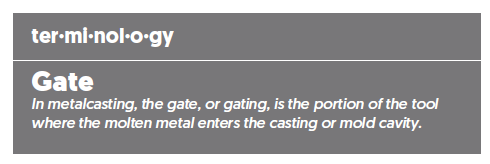Reducing Cost
Anthony Geiger, Foundry Engineer at Stainless Foundry & Engineering, Inc., is part of the up-and-coming generation of enthusiastic young metalcasters who will take the industry into the future. He has worked for Stainless Foundry since mid-2018. When you ask him if he likes his job at Stainless Foundry in Milwaukee, he says “I love my job.” He was his high school valedictorian and a Brady Corporation Academic All-Star. He earned his degree in Mechanical Engineering from the University of Wisconsin Milwaukee. He is fluent in Spanish.
Geiger has a reputation at Milwaukee’s Stainless Foundry & Engineering for diligence, enthusiasm, and being an exceptionally quick study. He has already learned important lessons from purchasing agents who buy castings from Stainless Foundry.
Casting Source: It sounds like your career is off to a great start. Can you tell us about one of the important things you’ve learned about Stainless Foundry’s customers?
Geiger: One of the big questions is “’why are my castings expensive,’ or ‘how can I reduce casting cost?’” More often than not, a quote comes to my desk, I look at the print and I see a lot of varying wall thicknesses, with thick areas tucked between thin areas. Immediately, I have three thoughts:
- I can redesign parts of your casting to avoid the thick-thin-thick-thin-thick.
- I more than likely need an elaborate assembly to gate where it makes sense to feed the casting and then the isolated locations that need attention. This really impacts the process. Injection, assembly, cleaning room, the labor goes up in all the areas.
- I can make an educated assumption at the application of your part and determine whether that area is critical or if the shrink can be buried in the casting wall there. Or I can communicate with the customer to see if it really is critical.
Casting Source: How do you begin a conversation with the customer about these three things?
Geiger: A great place to start with a potential part is to have a couple ideas for it modeled up or on a print, get in contact with the foundry engineer and let them mull it over for a while. They will give you their preferred design and critique it to make it easier to cast. A general rule of thumb is: Foundry engineers like a nice flat surface to gate on, and that area is to be the thickest section. Everywhere you go from there should be getting thinner and you can minimize a lot of potential issues.

Casting Source: Are there particular hurdles to get over in this process?
Geiger: A real dislike for a foundry engineer is a gating surface on one side of the casting and a thick section on the opposite side, with a bunch of thin sections or features in between the two. That is a quick way to increase the cost of a casting. Now, that’s not to say all of those thick-thin-thick-thin-thick section castings are un-castable. They just require another level of cost and workmanship. There certainly are high spec castings that are intricately designed—they can be a pain in the butt for a foundry to manufacture—but it certainly can be done, just with more cost and care. That being said, there are some products that just adhere better to only a certain type of manufacturing process. That could include forging, casting, machining, additive manufacturing, etc.
Casting Source: It sounds like Stainless Foundry does everything it can to help the customer accomplish their goals, which is great customer service. What would you tell others about working in a foundry?
Geiger: There is so much room for growth as a young person in this industry. In general there is a big need for engineers in this world, and in the foundry, even more so. Most of my friends working here have been with the company almost twice as long as I have been alive. I am doing everything I can, every day, to learn from all their experiences (good and bad) and pick their knowledge filled brains. Besides that, it’s rad. How many places can you go to work and see molten metal being poured every day? I was nervous at first, as most people are, to make the big life change from college to full working adult, but I could not be happier with the industry, and especially the company I landed in.
Click here to see this story as it appears in the November/December 2019 issue of Casting Source.